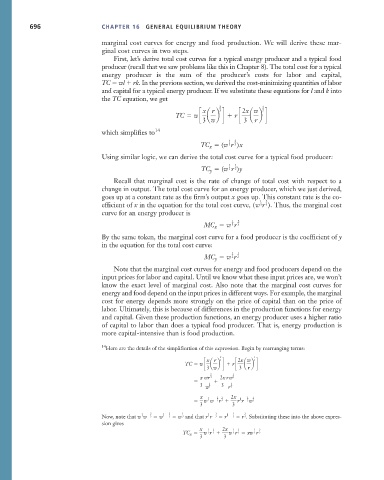Page 722 - Microeconomics, Fourth Edition
P. 722
c16GeneralEquilibriumTheory.qxd 8/16/10 9:14 PM Page 696
696 CHAPTER 16 GENERAL EQUILIBRIUM THEORY
marginal cost curves for energy and food production. We will derive these mar-
ginal cost curves in two steps.
First, let’s derive total cost curves for a typical energy producer and a typical food
producer (recall that we saw problems like this in Chapter 8). The total cost for a typical
energy producer is the sum of the producer’s costs for labor and capital,
TC wl rk. In the previous section, we derived the cost-minimizing quantities of labor
and capital for a typical energy producer. If we substitute these equations for l and k into
the TC equation, we get
2 1
x r 3 2x w 3
TC w c a b d r c a b d
3 w 3 r
which simplifies to 14
1 2
TC (w r )x
3
3
x
Using similar logic, we can derive the total cost curve for a typical food producer:
1 1
TC (w r ) y
2
2
y
Recall that marginal cost is the rate of change of total cost with respect to a
change in output. The total cost curve for an energy producer, which we just derived,
goes up at a constant rate as the firm’s output x goes up. This constant rate is the co-
1 2
efficient of x in the equation for the total cost curve, (w r ) . Thus, the marginal cost
3
3
curve for an energy producer is
1 2
MC w r 3
3
x
By the same token, the marginal cost curve for a food producer is the coefficient of y
in the equation for the total cost curve:
1 1
MC w r 2
2
y
Note that the marginal cost curves for energy and food producers depend on the
input prices for labor and capital. Until we know what these input prices are, we won’t
know the exact level of marginal cost. Also note that the marginal cost curves for
energy and food depend on the input prices in different ways. For example, the marginal
cost for energy depends more strongly on the price of capital than on the price of
labor. Ultimately, this is because of differences in the production functions for energy
and capital. Given these production functions, an energy producer uses a higher ratio
of capital to labor than does a typical food producer. That is, energy production is
more capital-intensive than is food production.
14 Here are the details of the simplification of this expression. Begin by rearranging terms:
2 1
x r 3 2x w 3
TC wc a b d r c a b d
3 w 3 r
2 1
x wr 3 2x r w 3
3 2 3 1
w 3 r 3
x 2 2 2x 1 1
w w r 3 r r w 3
1 3
1 3
3 3
2 2 1 1 1 2
1 3 w
1 3 r
Now, note that w w 1 3 w 3 and that r r 1 3 r 3 . Substituting these into the above expres-
sion gives
x 1 2 2x 1 2 1 2
TC x w 3 r 3 w 3 r 3 xw 3 r 3
3 3

